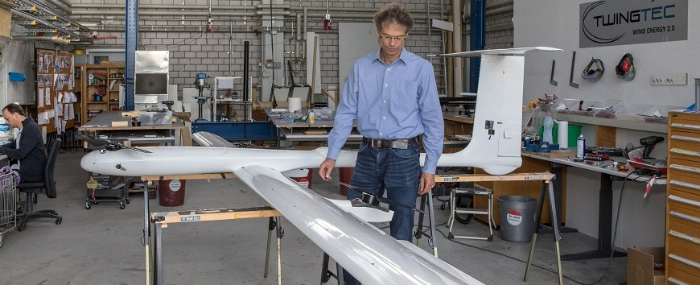
© EMPA
Electronics Production |
EMPA spin-off TwingTec takes flight
Anyone who has ever steered a child's kite knows the feeling: the wind grips the kite and pulls the string. The rope is quickly tensioned, the pulley rotates between the fingers and is difficult to control. The question arises: Could this wild energy not only be used to play, but also to generate electricity?
To harvest wind energy, you don't necessarily need rotors on steel masts – light kites on thin ropes can do the same. The Empa spin-off TwingTec has been researching this technology for some time now. In autumn 2018, it was possible to generate electrical energy while flying and then land again, all in the specified level of automation. The latest Twingtec prototype is about to get airborne in November 2019.
The idea behind the project is simple, but the practice is tricky: meteorologists know that at a height of 500 meters wind power is up to eight times stronger than at a height of 120 meters – which is the hub height of modern wind turbines. A kite could make use of this strong wind if it screws its way up in circles and pulls a rope from a pulley. A generator that produces electricity is connected to the axis of the rope pulley. As soon as the rope has been unwound, the kite glides back towards the ground station; in the meantime, the rope is wound up and the ascent begins anew. "The big challenge is not flying itself," says Rolf Luchsinger, CEO of Empa's spin-off TwingTec. "The problem is to take-off and land automatically. After all, the kite power station should be able to supply electricity without being controlled by humans.
Automated flight successful
In autumn 2018, this was exactly what happened on the mountaintop of the Chasseral in western Switzerland (The Chasseral is a mountain overlooking Lake Biel in the Swiss canton of Bern.). TwingTec prototype T28, a device with a wingspan of three meters, started from its base vehicle, climbed up into the air, circled autonomously for 30 minutes, produced electrical energy and finally landed safely on the launch platform. Now comes the next step: continuous power generation for customers.
Luchsinger's team is currently working on the T29 prototype, which is scheduled to be in operation for a longer period of time at the Chasseral in November 2019. T29 will not only automatically take off and land, but will also generate up to 10 kW of electrical power and feed it into the grid. BKW, a utility of Berne, is in charge to transmit the experimental wind power to the first consumers.
The route from the first sketch to the first kilowatt-hour of grid electricity was long and winding. In the beginning, there was the idea of using a kite reinforced with compressed air, similar to kite surfing. Research on a number of prototypes led to a structure with rigid wings. Steering with several ropes was also discarded in favour of a control system with flaps like an airplane. TwingTec uses small rotors for take-off and landing, similar to a drone. In 2014, TwingTec filed a groundbreaking patent for the take-off and landing technology of the energy kite, which has since been approved in several countries.
A glance at the numerous competitors shows just how promising energy kites could soon be. In Europe alone, ten start-ups and several teams from universities and technical colleges are developing solutions for this type of energy generation.
The findings from the flight tests with the T29 are aimed at making a first series product possible: the TT100, an energy kite with a wingspan of 15 meters. Placed on a standard shipping container, the kite is to take off and land automatically and generate up to 100 kW of electrical power – which would be sufficient for 60 single-family homes.
However, in the Swiss mainland you will probably never see energy kites. "Wind power is not suitable for densely populated areas," says TwingTec CEO Rolf Luchsinger. Customers for this sustainable form of energy generation rather live in remote areas. "We are talking to mining companies, mayors of remote settlements and people on islands. Today those places mostly use diesel generators that emit exhaust gases and noise. Besides that, diesel fuel has to be delivered at great expense to these places." Autonomously working TwingTec kites could save diesel and take over the entire energy production in the medium term. In the long term, however, Luchsinger has even bigger plans: to build floating wind farms on the sea with his energy kites. There is plenty of space and wind, and energy-kites won't bother anyone. This is precisely what wind energy needs to speed up the energy revolution.



